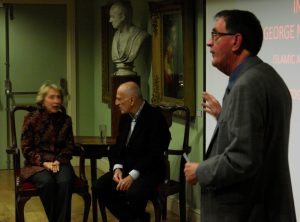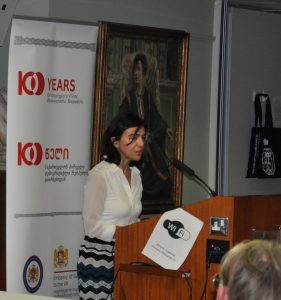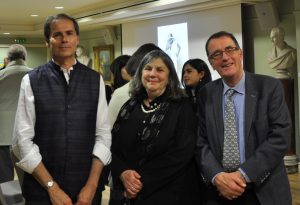A Literary Quartet – from Raj Postcards to Architecture
In the past week we have been pleased to be part of the launches for four very different, but equally exciting, books.
On Friday 2 November we welcomed George Michell and Helen Philon for their conversation on the Islamic architecture of the Deccan to introduce their full-colour publication “Islamic Architecture of Deccan India” with photographs by Antonio Martinelli. Both showed their keen knowledge of the subject and their passion for exploring new hypotheses concerning the influences and uses of the many different examples of magnificent architecture of the region.

On Tuesday 6th November, with the embassy of Georgia, we celebrated the launch of “Unlocking the Door: Writing from Georgia”. The book is a pioneering new work that contains pieces of translation from Georgian by students of the University of Oxford, supervised and edited by Ms. Lia Chokoshvili, with editorial assistance by Professor Donald Rayfield and generous support from Marjory Wardrop Fund. ‘Unlocking the Door’ brings together short stories, fairy tales, and plays by Aka Morchiladze (including two works that have never appeared in print before), Guram Rcheulishvili, Lasha Tabukashvili, Erlom Akhvlediani, and Goderdzi Chokheli, in a bilingual, facing-page format.

Wednesday 7th November saw the launch of “Paper Jewels: Postcards from the Raj”, with author Omar Khan providing a delightful insight into this topic. The book reveals the story of postcards during the Raj period. It uncovers such gems as the early postcards of the great Indian painter M. V. Dhurandhar and the Ravi Varma Press in Mumbai, the exceptional work of an early Austrian lithographer in Kolkata, a British photographer in Peshawar, and Indian studios in Jaipur, Kashmir, Delhi, Lahore, Madras, Karachi and elsewhere. The books is sourced almost entirely from new primary research in archives and private collections in India, Pakistan, Europe and the US, and explores the many artistic, business, fashion, political and technical developments that contributed to the rise of this medium.

Then, last night, Thursday 8 November, the RAS joined the Royal Society for Asian Affairs at the Brunei Gallery, SOAS, for the launch of Christoph Baumer’s book “The History of Central Asia: The Age of Decline and Revival”. For more than a hundred years, Central Asia was a heartland of military power. But after fragmentation of Mongol polity, the region began a steep decline which reached its nadir in the second half of the nineteenth century. In this concluding volume of his Central Asia quartet, Christoph Baumer shows how China in the east, and Russia in the northwest, succeeded in throwing off the Mongol yoke to become the masters of their own previous rulers. This epic history concludes with an assessment of the transition to modern independence of the Central Asian states and their struggle to contain radical Islamism.
Next week we welcome Moin Mir in conversation with Dr Rosie Llewellyn-Jones about his new book “The Prince Who Beat the Empire: How an Indian Ruler took on the might of the East India Company”. The book examines the story of the fall of Surat, Mughal India’s greatest port, to the English East India Company and the moving story of the rebel prince of Surat who beat the world’s most powerful colonising corporation. This event takes place at 6.30 pm on Thursday 15th November and we hope that we will be able to welcome many to this event.
